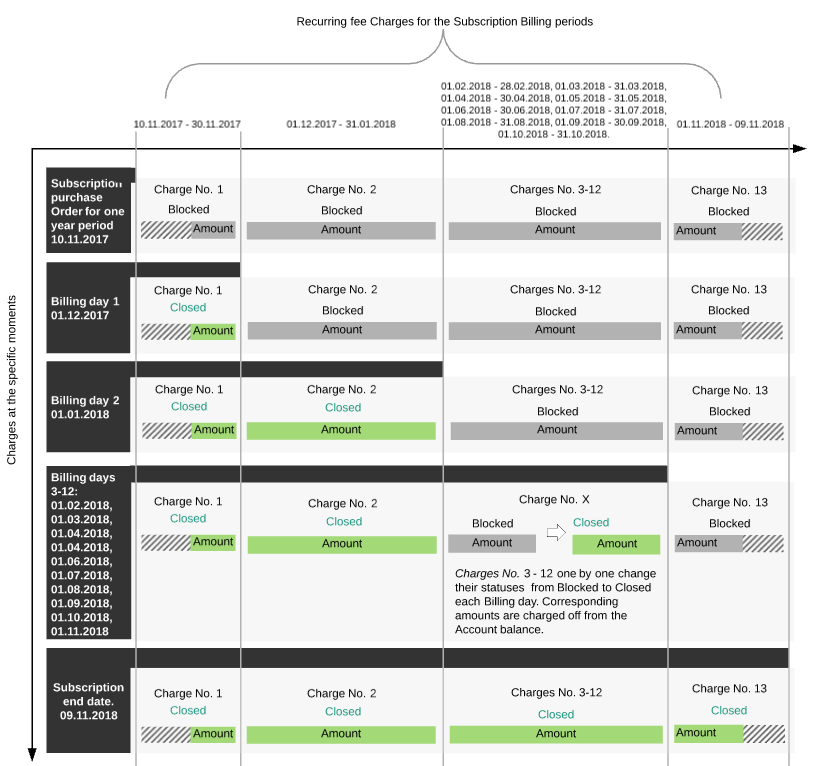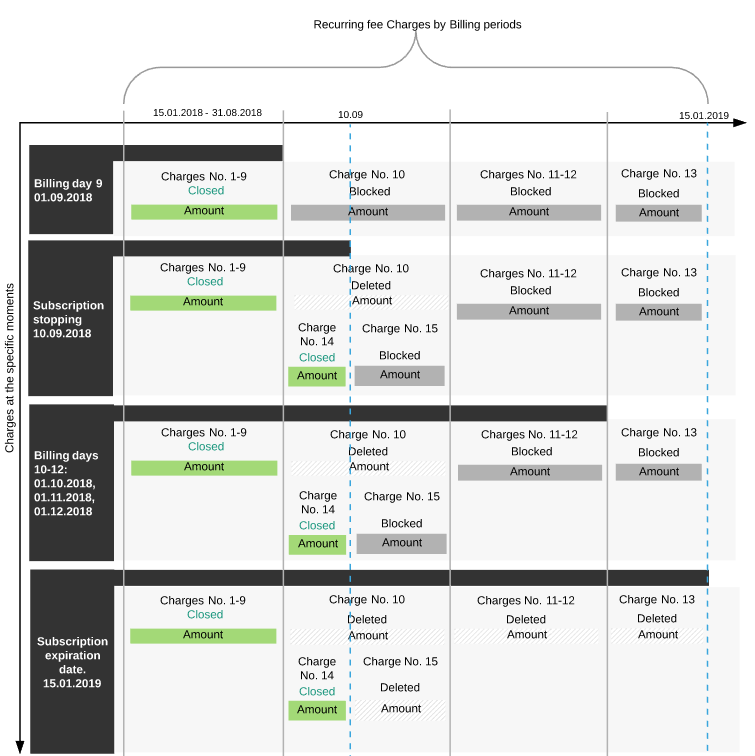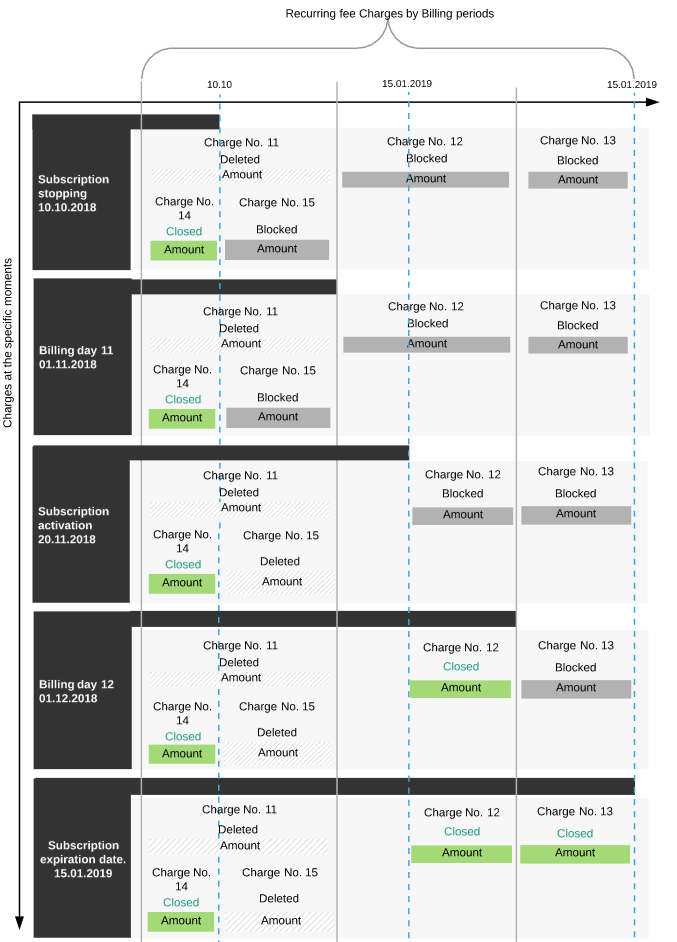Monthly Long-term. Charges generation
Unlike other billing types, Monthly Long-term uses the same charge generation pattern for the Prepay and Postpay model (excluding subscription stopping). This article describes charge generation for both models but uses the Prepay model for examples. For the Postpay model, consider the current debt instead of the account balance for accumulating the charges amount (see Specifics of managing postpaid subscriptions). See also Particular aspects of charges in different currencies.
The Monthly Long-term billing type is applied to subscriptions with annual payments. Monthly Long-term complies with the billing rules of the Microsoft CSP program.
In this article:
General rules for the Monthly Long-term billing type
- The Monthly Long-term billing type supposes that the total price of the ordered subscription and its resources for the full period (usually 1 year) is paid before the subscription provisioning.
- All charges are generated at the moment of the order creation with the New status and get the Blocked status when the order is paid.
- Charges are generated for the full subscription period at once.
- Usually, all charges for subscriptions with the Monthly Long-term billing type are closed right away — manually (see Closing subscription charges manually) or automatically with a script (see Charges closing with Charge Closer). The generation and changing of the charges in that case are described in Manual closing of the subscription charges.
For a Microsoft NCE subscription with a single payment (P1Y:Annual and P1M:Monthly) for a shortened period because it was purchased or renewed with the expiration date alignment:
- The number of charges and the period of the last charge are reduced according to the shortened subscription period.
- The end date of a sales order is limited by the selected subscription expiration date if it is closer than the end of the Cancel unpaid order in period in the account class.
Recurring fee charges
Recurring fee charges are generated when an order is created and have the following default attributes:
- Status: New.
- Created at: order creation date.
- Close date: order creation date.
- Period: one of the subscription billing periods.
For a one-year subscription with the Monthly Long-term billing type, 13 Recurring fee charges for each resource type usage are generated. The charges are generated at the start of the subscription paid period. The amounts of the charges No. 2-12 are fixed and are equal to the monthly price of the subscription. Charges No. 1 and 13 are generated as it is described in Charges default attributes.
If the order for the subscription purchase was submitted on the billing day, only 12 charges will be generated.
When the order is paid, charges No. 1-13 get the Blocked status and block the funds at the account balance. On the nearest billing day, the charge No. 1 get the Closed status, and its amount is withdrawn from the account balance. On the next billing day, the charge No. 2 get the Closed status, and its amount is withdrawn from the account balance, etc.
Setup fee, Renewal fee, and Transfer fee charges
There are no Setup fee, Renewal fee, and Transfer fee charges because the corresponding fees should not be applied.
Subscription ordering
When a subscription is ordered, Recurring fee charges for the additional quantity of resources are generated.
An example of a subscription with the Monthly Long-term billing type is given below:
An annual subscription is ordered and paid on 10.11.2017. At that moment, the following occurs:
The case when an order was paid after the date of its creation is described in the Charges attributes changing article.
Charges No. 1-13 for each billing period during the full period of the subscription are generated.
- Charges amounts are calculated using a standard formula (see Charges default attributes).
- Charges No. 1-13 get the Blocked status.
- The sum of the charges No. 1 — 13 amounts is blocked at the account balance.
- On the nearest billing day (in this example, it is 01.12.2017), the following occurs:
- Charge No. 1 gets the Closed status.
- The amount of the charge No. 1 is withdrawn from the account balance.
- On each next billing day up to the 12th inclusive, the next charge gets the Closed status, and the corresponding amount is withdrawn from the account balance.
- On the end date of the subscription period, which is equal to the date of the subscription purchase + one year — one day (09.11.2018 in the example):
- Charge No. 13 gets the Closed status.
- The amount of the charge No. 13 is withdrawn from the account balance.
Change order. Upgrading resources
When additional resources are ordered, Recurring fee charges are generated for each resource type. Generation and changing of attributes of these charges are similar to the generation and changing of attributes of charges for subscription purchasing (see the Subscription ordering section).
Change order. Downgrading resources
For downgrading resources, the charge behavior depends on whether the subscription charges are already closed.
If the subscription charges are not yet closed, the Recurring fee charges are split (see Splitting of charges when the resource quantity is reduced).
If the subscription charges are already closed:
- When a change order for downgrading resources is created:
- The closed charge does not split.
- Charges in the New status are created for a period from the order creation date split by billing periods and a negative amount for a refund for the reduced resource quantity (the order creation date is refunded).
- When a change order for downgrading resources is completed:
- The closed charge does not split.
- All charges in the New (and Waiting for refund) status are deleted.
- Instead of them, one charge in the Closed status is created for the rest of the subscription period starting from the order completion date and a negative amount for a refund for the reduced resource quantity.
Subscription stopping (Prepay)
In the Customer Control Panel, stopping a subscription manually is not available.
The stopping of the subscription causes the following:
- The charge for the current billing period is deleted. The account balance is increased by the charge amount.
- A new charge for the actual period of the subscription usage in the current billing period is generated with the following attributes:
- Status: Closed.
- Created at: the date of the subscription stopping.
- Close date: the date of the subscription stopping.
- Amount: is proportional to the actual subscription usage period in the current billing period taking into account the actual number of days in a month (see Charges default attributes).
- Discount: is proportional to the charge amount.
- Period: from the start of the current billing period to the date of the subscription stopping.
- A new charge for the remaining part of the current billing period is generated with the following attributes:
- Status: Blocked.
- Created at: the date of the subscription stopping.
- Close date: the nearest billing day.
- Amount: is proportional to the remaining part of the current billing period taking into account the actual number of days in a month (see Charges default attributes).
- Discount: is proportional to the charge amount.
- Period: from the date of the subscription stopping to the nearest billing day or to the subscription expiration date.
- The charges for the future billing periods are not changed until the subscription is activated, or is deleted, or its expiration date occurs.
Subscription stopping (Postpay)
In the Customer Control Panel, stopping a subscription manually is not available.
The only difference from the Prepay model is that a new charge for the actual period of the subscription usage in the current billing period is generated in the Blocked status. The current debt is calculated as the total amount of all blocked charges.
Subscription activating
The activation of a subscription causes the following:
- The charges in the Blocked statuses for the previous billing periods get the Deleted statuses. The account balance is increased by the sum of amounts of the charges.
- The attributes of the charge for the current billing period are changed as follows:
- Status: Blocked.
- Created at: the date of the subscription activation.
- Close date: the nearest billing day.
- Amount: is proportional to the remaining part of the current billing period taking into account the actual number of days in a month (see Charges default attributes).
- Discount: is proportional to the charge amount.
- Period: from the date of the subscription activation to the nearest billing day or to the subscription expiration date.
- After that, the charges changing of attributes is carried out in a standard way, which is described in the Subscription ordering section.
Subscription renewing
To extend a subscription to another period, delayed renewing is used with the ability to increase or reduce the quantity of resources (see Delayed renewing of a subscription).
When the subscription renewal order is submitted, Recurring fee charges for the additional resources renewal are generated. Separate charges are generated for each resource type. The generation and attributes changing of the charges of this type are similar to the generation and attributes changing of the Recurring fee charges for the subscription purchase.
When the subscription with the Stopped or Graced status is renewed, it is activated automatically after the order and the debt are paid.
Subscriptions are automatically renewed as follows:
- Before the specified number of days to the expiration date of a subscription ordered for 1 year, a renewal order is created.
- Recurring fee charges are generated for the next period of 1 year.
- Charges are generated in the New status.
- The first charge is generated for a period starting from the next day after the subscription expiration date.
- If there are enough funds on the account balance, the subscription is renewed:
- All the charges get the Blocked status.
- The expiration date of the subscription is set as its current expiration date + 1 year.
- If there are not enough funds on the account balance, the subscription is stopped. To activate the subscription, a customer need to pay for the renewal order.
- If a customer pays for the renewal order after the subscription expiration date:
- The period and expiration date of the subscription are calculated considering the Expired subscription is renewed settings in a service term (see Creating a service term).
- For the first charge generated for the period till the next billing day, the start date is set to the renewal order payment date, and the charge amount is recalculated, respectively.
- For the last charge generated, the period and amount are changed if the new subscription expiration date is moved, considering the renewal order payment date.
Plan switching
The immediate switching of the plan (see Switching a plan) is performed with the standard splitting of blocked charges (see Splitting of charges when a subscription plan was switched). In contrast, for a charge in the Closed status, a new charge in the Closed status is created with a negative amount that covers the unused part of the subscription period.
The delayed switching of the plan is available if the Paid to date is equal to the subscription expiration date. Switching the plan, in this case, is performed together with renewing a subscription. A switch plan order is created as delayed (Delayed = Yes and Provisioning date = the subscription expiration day, see Delayed switch plan order in Switching a plan):
- For a switch plan order, charges are generated in the New status from the subscription expiration date for a period depending on the billing type and period of the new plan.
- For a switch plan order in the Waiting for provisioning status:
- The charges remain the New status.
- For the Prepay model, the amount of the charges is blocked on the account balance.
- After completing a switch plan order:
- The charges get the Blocked status.
- The subscription expiration date is changed.
- The Paid to date is changed.
Subscription deleting
When an active subscription is deleted, the standard charges splitting occurs (see Splitting of charges when a subscription is deleted).
When a stopped subscription is deleted, all charges in the Blocked status are deleted, and the account balance is increased by the sum of their amounts.




